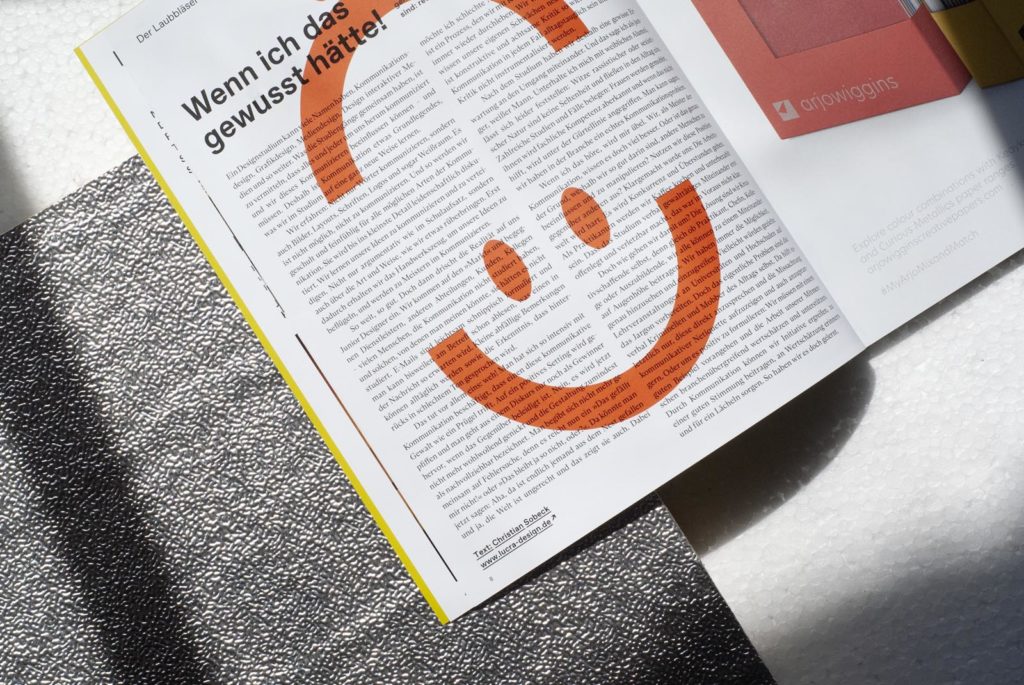During your studies and training, you learn the tools of the trade for your future career - ideally. The skills and knowledge you actually need often only become apparent in practice. We asked creative people what they wish they had known and what tips they would give others along the way.
We start with a comment by Christian Sobeck, but you are also welcome to share your experiences or suggestions via the comment function ...

A design degree course can have many names. Communication design, graphic design, media design, interactive media design and so on. What the courses have in common is that they teach us that everything and everyone around us communicates and that we can - and must - influence this communication. Communication is therefore something fundamental that we learn in a completely new way during our studies.
We learn: Not only words communicate, but also images, layouts, fonts, logos and even white space. It is not possible not to communicate. And so we become trained and sensitive to all kinds of communication. It is passionately discussed down to the smallest detail. We learn to communicate and defend our ideas. Not just argumentatively, as in a school essay, but also through the way we get something across. This is what gives us the tools to inspire our ideas and make us masters of communication.
So far, so good. But then reality hits us junior designers. We enter the "market" and encounter service providers, other departments, customers, colleagues - many people who have not studied communication and those who you might think have not. E-mails are worded in a carelessly flippant manner and you can sometimes tell from the subject line what to expect in the message. Small snide remarks can become commonplace as well as the realization that people are speaking in a bad tone behind your back.
That hurts one thing above all: it hurts! You have worked so intensively on communication that this communicative violence hits you like a blow.
A positive setting is ignored and you only emerge from a discussion as a winner if the other person is offended. No, people no longer nod benevolently and at least describe the design as comprehensible. People no longer go in search of mistakes together, because all it takes now is a "I don't like that!" or "It won't stay that way, will it?". You could say: aha, someone has finally fallen out of the nest and yes, the world is unfair and it shows. I don't want to justify bad work. But design is a process that we go through again and again with customers, colleagues and superiors. We become more experienced in the process and know how to realign our own weaknesses, which is why constructive and mindful criticism is so important. Communication must always be suitable for everyday use and must not be instrumentalized as criticism.
After university, we therefore have a certain expectation of how we should treat each other. And I say that as a young, white man. Unfortunately, when I talk to female alumni, it becomes clear: Jokes of a racist or sexist nature are not uncommon and flow into everyday life. Numerous studies and cases prove this: Women are bullied, they are denied professional competence and if that doesn't help, they are attacked below the belt. You could say that we have a real communication problem in the industry.
When I hear that, I feel sick. We, as masters of communication, know much better.
Or is that exactly why we are so good at influencing and manipulating other people? Do we take advantage of this position over others? It has been made clear to us: the world of work will be tough. There will be competition and overtime. As interns, we will make coffee and be underpaid. It was not clear in advance that studying would expose verbally violent interaction and make us vulnerable.
But how do we deal with this? The solution is us creative professionals ourselves, because whether intern, boss, colleague or apprentice, we can all contribute to working together as equals. We always have the opportunity to take a closer look and intervene. Perhaps targeted courses at universities and colleges would prepare us for the jargon. But the real problem is the verbal criminals and bullies of everyday life themselves. Ultimately, it only helps to address them directly and to point out and denounce their disregard for communicative netiquette. Or to put it in positive terms: We need to set a good example and appreciate and support the work of our fellow human beings across all sectors. Through communication, we can take the initiative, contribute to a good atmosphere, remind people to show appreciation and make them smile. That's what we've learned.
Text: Christian Sobeck
www.lucra-design.de

For our questions column and for the leaf blower, we asked various creative people about their conclusions from their training or studies ...
"Studying is a utopian place for design, you should understand this as quickly as possible in order to be able to use it for yourself." - Colin Dörffler
"I studied at the Blocherer Schule in Munich and in the first four semesters I felt I had every drawing instrument in my hand, in other words the classic craft; I really appreciate that." - Franziska Schatz
"I would say I learned very little about working life overall, but that's exactly why it was fun. It was an experimental time that I wouldn't want to miss because of the freedom to explore my own interests or discover new ones." - Julia Schubert
"Always try to think around corners and go one step further, even if you think you've already reached your goal." - Noëm Held
"One thing I learned from my time studying design at the UAS is to demand what you want to be taught. No training period is perfect, but it is always possible to make the best of it." - Steffi Bauer
"After that, you know what you think you can and want to do and the real work begins." - Thomas Pokorn
"For me, university was either too early or I was in the wrong studio for me. In any case, I got more blocks than it necessarily supported me in what I was good at. Even when I went to university, my interests were custom type and lettering. At university, I mostly did visuals for theater festivals or other non-obvious things. I came to design and university unbaked and angsty from skate logos. I have the feeling that the students there are shaped and pressed as if by a punch, instead of recognizing a unique approach to design in everyone, supporting it and thus guiding it." - Kristina Bartosova
In addition to the usual knowledge about tax, freelance bureaucracy and negotiating fees, I initially lacked confidence in communicating with clients. But I really had to learn the hard way when it came to representation. As a newcomer, you think, great, I have an agent who takes care of orders and contracts and all I have to do is be creative. In fact, you have to be constantly on the mat with representatives and nag them to keep you in mind. You should also stay away from exclusive contracts, unless you're a superstar. It's better to handle jobs that you've organized yourself instead of being charged 50 euros in telephone charges afterwards by the representative, as happened to me. Robert Bartholot, photographer
Appearing too shy or too self-confident or even arrogant does not help career starters, although far too many unfortunately seem to believe this. It is therefore very important to quickly find a balance between modesty and self-confidence.
Despite a modest appearance, it is very important to show your own projects and work to as many people as possible in order to create opportunities. Contacting the press can potentially move mountains - with well-prepared texts of course, print-ready and web-ready data and of course a few friendly words. Scouting instead of hoping to be discovered must be the motto. Tomi Vollauschek, graphic designer Fl@33





